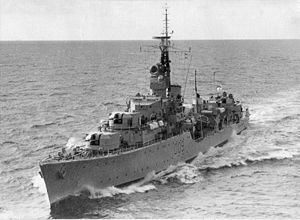Name HMS Dunkirk Laid down 19 July 1944 Decommissioned 1963 Construction started 19 July 1944 Length 116 m | Ordered 1943 Commissioned 27 November 1946 Fate Broken up 1965 Launched 27 August 1945 | |
 | ||
Builder Alexander Stephen and Sons | ||
HMS Dunkirk (D09) was a later or 1943 Battle-class fleet destroyer of the British Royal Navy (RN). Though there were other ships of the Navy that had been named Dunkirk, as far back as the 1650s, it held added meaning after the dramatic, and at times, tragic and heroic evacuation from Dunkirk between late May and early June 1940, in which over 300,000 British, as well as French troops, were rescued by a ragtag fleet of ships.
Contents
Dunkirk was built by Alexander Stephen and Sons of Govan. She was launched on 27 August 1945 and commissioned on 27 November 1946.
Service
In the year of her commissioning, Dunkirk joined the 4th Destroyer Flotilla of the Home Fleet. In 1950, Dunkirk was placed in Reserve, as were many of her sister-ships in the 1950s. She subsequently performed a variety of duties and in 1958, while in the Mediterranean, Dunkirk, in broad daylight, collided with her sister-ship HMS Jutland during naval manoeuvres off Malta, causing minor damage.
In 1961, Dunkirk, along with the cruiser HMS Lion and the frigate HMS Leopard, undertook a tour of the South American continent. Instead of returning home to the UK from the deployment's culmination Dunkirk deployed to the Mediterranean to take up the duties of HMS Broadsword, a Weapon-class destroyer of the 7th Destroyer Squadron, based in the Mediterranean, which had experienced some engine problems and therefore had to be replaced. Dunkirk finally returned home in 1963.
Decommissioning and disposal
In 1965 'Dunkirk was listed as 'reserve' and later that year was scrapped at Faslane.
